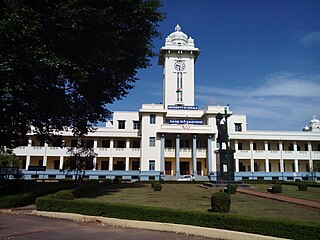
The Bronx High School of Science is a public specialized high school in The Bronx in New York City. It is operated by the New York City Department of Education. Admission to Bronx Science involves passing the Specialized High Schools Admissions Test.

The Academy for Mathematics, Science, and Engineering (AMSE) is a four-year magnet public high school program intended to prepare students for STEM careers. Housed on the campus of Morris Hills High School in Rockaway, in the U.S. state of New Jersey, it is a joint endeavor between the Morris County Vocational School District and the Morris Hills Regional District.

The University of Kelaniya is a public university in Sri Lanka. Just outside the municipal limits of Colombo, in the city of Kelaniya, the university has two major institutions and seven faculties.

Science, technology, engineering, and mathematics (STEM) is an umbrella term used to group together the distinct but related technical disciplines of science, technology, engineering, and mathematics. The term is typically used in the context of education policy or curriculum choices in schools. It has implications for workforce development, national security concerns, and immigration policy, with regard to admitting foreign students and tech workers.

The Philippine Science High School System is a research-oriented and specialized public high school system in the Philippines that operates as an attached agency of the Philippine Department of Science and Technology. PSHS is considered as the top science high school in the Philippines and is viewed to be among the best in the ASEAN region by 2016.
The Hellenic Open University was founded in 1992 in Patras and is the only online/distance learning university in Greece. Modelled on the British Open University, the Hellenic Open University was established to fill a gap for telematic and distance education in the higher education system of the Hellenic Republic in response to the growing demand for continuing education and lifelong learning.

Colegio San Agustin – Biñan, is a private, Catholic coeducational basic and higher education institution run by the Augustinian Province of Santo Niño de Cebu, Philippines of the Order of Saint Augustine in Biñan, Laguna, Philippines. It was founded by the Augustinians 1985.

Chittagong University of Engineering & Technology, commonly referred to as CUET, is a public engineering and technological research university in Bangladesh located in Raozan in Chittagong. Established in 1968 as the Chittagong Engineering College and gained autonomous graduate school status in 2003, this university is a state funded institution, maintaining special emphasis on teaching and research of engineering, technology, architecture and planning under five faculties and seventeen academic departments.

Cagayan National High School, abbreviated as CNHS and locally known as Cagayan High, is the universal high school of Region 2. It is located in Taft Street, Tuguegarao City, Cagayan, Philippines. Established in 1905, it is the oldest public secondary level school in Cagayan and the province's premier secondary school.

The Technische Universität Ilmenau is a German public research university located in Ilmenau, Thuringia, central Germany. Founded in 1894, it has five academic departments (faculties) with about 4,900 students. Teaching and research are focused on the fields of technology, mathematics and natural sciences, business and media.

The importance and antiquity of education in Kerala are underscored by the state's ranking as among the most literate in the country. The educational transformation of Kerala was triggered by the efforts of both Church Mission Society missionaries like Jon Munro and clergy of Catholic church like Fr Kuriakose Elias Chavara and Fr Charles Lavigne and were the pioneers that promoted mass education in Kerala, in the early decades of the 19th century. The local dynastic precursors of modern-day Kerala, primarily the Travancore Royal Family, the Nair Service Society, Sree Narayana Dharma Paripalana Yogam, and Muslim Educational Society (MES), also made significant contributions to the progress on education in Kerala. Local schools were known by the general term kalaris, some of which taught martial arts, but other village schools run by Ezhuthachans were for imparting general education. Christian missionaries and British rule brought the modern school education system to Kerala. Ezhuthu palli was the name used in earlier times. The word was derived from the schools run by the Buddhist monasteries. For centuries, villages used to set up an ezhuthupally or ashan pallikoodam with one or two teachers. Students used to go this school from nearby areas and learn languages, literature, mathematics, grammar etc. After completing this, students may continue study about specific subjects such as ayurveda, astrology, accounting etc. Censuses during the 1800s showed that Travancore, Cochin, and Kannur areas have many such schools.
Caraga Regional Science High School is a public school in San Juan, Surigao City, Philippines. It is the leading school in the Division of Surigao City with high MPS during the annual National Achievement Tests (NAT), and has been consistent in making its name in Division, Regional, National and International level contests.
Waxahachie Global High School is a high school in Waxahachie, Texas, founded in 2007 on the historic T.C. Wilemon campus. It is one of only 91 STEM academies in the state of Texas. It was additionally granted Early College High School status in 2009 through a partnership with Navarro College, allowing students to earn an associate degree along with their high school diploma. Recently, as of the start of the 2013-2014 school year, Global High made a partnership with UT Tyler for all the STEM-based college courses offered at Global. As a public charter school, students from Ellis County and surrounding areas can attend regardless of zoning. Many students commute from surrounding cities such as Waxahachie, Red Oak, Ennis, Maypearl, Midlothian, Palmer, Italy, Cedar Hill, and Desoto. In 2014, Waxahachie Global was named the "Best High School" by the U.S. News & World Report. Starting in the 2018-19 school year, the Global campus is located in the Billy R. Hancock Building.
The education system in Lahore is formulated along specific modern, religious, cultural, social, psychological, commerce and scientific injunctions. Lahore is Pakistan’s largest producer of professionals in the fields of science, technology, IT, engineering, medicine, nuclear sciences, pharmacology, telecommunication, biotechnology and microelectronics. Most of the reputable universities are public, but in recent years there has also been an upsurge in the number of private universities. The current literacy rate of Lahore is 64%. The standard national system of education is mainly inspired from the British system. The system also aims to imbibe a secular outlook among the students with the awareness of the rich cultural heritage of Pakistan. Lahore has a wide range of schools, colleges and universities that caters to diverse streams.
Pacita Complex National High School (PCNHS), also known as Pacita NHS, is a public secondary high school in San Pedro, Laguna, in the Philippines. It was founded on 13 November 1997, began offering education in 1999, and now runs a curriculum in science, technology, and engineering program and secondary basic education.
Stonyhurst Southville International School is a learning institution in the province of Batangas, Philippines, and one of the Southville Global Education Network (SGEN) schools.
Sogeri National High School is a school situated in Sogeri in the Central Province of Papua New Guinea (PNG). It was the country's first national high school and it educates students from all over the country in Forms 5 and 6, prior to their going on to tertiary education. Many of PNG's leading politicians, administrators, business people and academics have been educated at the school. It was described by the country's first prime minister, Sir Michael Somare, himself a former pupil, as "the school that shaped the nation".
Kerevat National High School, also known as the Kerevat School of Excellence, is a government high school in the East New Britain Province of Papua New Guinea (PNG) that takes admissions from throughout PNG for Grades 11 and 12. It was founded in 1947.
Port Moresby National High School is one of the six national government high schools in Papua New Guinea (PNG) and the only one that does not offer boarding facilities. It was officially opened on 1 June 1995. The school's intake is limited to Grades 11 and 12 and it has more than 600 students and 50 staff.
Wawin National High School is one of the six government-run national high schools in Papua New Guinea, which are also known as "Schools of Excellence". The coeducational school caters for Grades 11 and 12 only, and is a boarding school.










